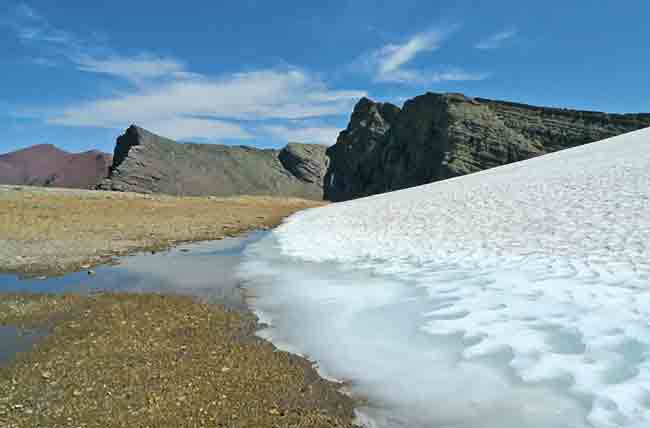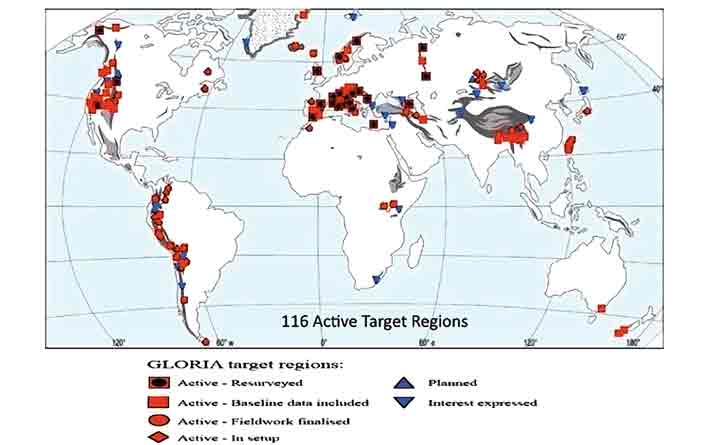[The Montana Professor 24.1, Spring 2014 <http://mtprof.msun.edu>]
Martha E. Apple, PhD
Associate Professor of Biological Sciences
Montana Tech-UM

Alpine plants and their environments are sensitive to climate change (Gottfried et al., 2012; Pauli et al., 2012). The following is an account of three related research projects that share the goal of predicting and discovering trends in the responses of alpine plants to climate change.
Glaciers and snowfields are intrinsic parts of the alpine landscape at Glacier National Park; however, they are retreating and shrinking at a rapid rate (Watson et al., 2008; Fagre, 2010). In this project (initiated in the summer of 2012 and funded through RM-CESU), we study plants growing at the edges of snowfields, where melting snow provides water during the brief alpine summers. These rare peripheral plants are so-called because of their scarcity and/or because they live in Waterton-Glacier International Peace Park at the southern edge, or periphery, of their arctic-alpine ranges, which extend northward into Canada.
To study these plants, we established pairs of geospatially referenced transects, marked by cairns, at the lateral edges and toes of snowfields at Glacier National Park. The paired transects were placed at a large and steep snowfield near Siyeh Pass; at a smaller and less steep snowfield, or nivation hollow, in Preston Park; at a snowfield on the summit of Piegan Pass; and at a more ephemeral snowfield on Mt. Clements near Logan Pass. At 5m intervals along each 50m transect, we placed 1m2 quadrats above and below a measuring tape. We photographed the resulting 2m2 area and recorded the presence and percentage of ground covered by different species of vascular plants, mosses, and lichens, as well as the percentage of ground consisting of rocks, snow, and soil. We constructed a list of vascular plant species found along the transects and at other nearby scouting locations such as isolated snowfields along cliff bands at Mt. Clements and Siyeh Pass; the edge of the Sexton Glacier; the Mt. Clements moraine; and at alpine fens, tarns, springs, and bogs. In addition, we searched for rare peripheral arctic-alpine plants in all of these locations (Apple 2012).

The snowfield at Mt. Clements turned out to be ephemeral. Although it was extensive in late July 2012, a rain-on-snow event took place in early August, and by mid-August, the seemingly permanent snowfield had melted completely. In one day, the edge melted 4.2 meters inward. The edge of a snowfield changes constantly, as does the edge habitat, which is characterized by the availability of cold water from the melted snow. The substrata on the edges of the snowfields were generally a combination of rock and scree, with soil increasingly visible with distance from the snowfield's edge. Lichens on rocks near the snowfields can be used as indicators of how long an area has been free of snow and are thus valuable tools in determining a snowfield's recent extent. Since the edges of snowfields can be visualized from above, it is likely that our group will begin looking at ortho-rectified images (courtesy of archeological and other researchers at Glacier National Park) of the snowfields to determine changes in snowfield edges with time. If so, we will have a basis to establish the spatial and temporal boundaries of the snowfields.
In 2012, most plants found within 5m of the edges of snowfields were usually not the rare peripheral arctic-alpine species; nor were they the showy-flowered species often featured in field guides. Instead, abundant species included Oxyria digyna, the mountain sorrel, which is a member of the buckwheat family (Polygonaceae); Epilobium anagallidifolium, a willow herb in the evening primrose family (Onagraceae); Carex sp. in the sedge family (Cyperaceae), and Phacelia hastata, a member of the waterleaf family (Hydrophyllaceae). Other species found near snowfields include Arnica alpinum, the alpine arnica in the sunflower family (Asteraceae); Ranunculus sp. in the buttercup family (Ranunculaceae), and Arabis lemmonii in the mustard family (Brassicaceae). Species richness (a measure of the number of species per area) increased with distance from the snow. Rare, peripheral arctic-alpine species were found, but not necessarily near the edges of snowfields. For example, Papaver pygmaceae, the pygmy poppy (Papaveraceae), was found on the rocky fell field near the toe of the Siyeh Pass snowfield, while Aquilegia jonesii, the Jone's columbine (Ranunculaceae), was found on a rocky ridge near the lateral edge of the Siyeh Pass snowfield. Cushion plants were generally not found along the immediate edge of snowfields but were found some meters away, possibly beyond the limits of continuous or nearly continuous snow cover, as these plants grow slowly and can live for many decades.
Interestingly, immature fruit tissue of Silene stenophylla from Siberia was radiocarbon dated with accelerator mass spectroscopy to be 31,800 ± 300 years old and regenerated via tissue culture and clonal micropropagation into fertile plants (Yashina et al., 2012). A close relative of S. stenophylla is the abundant moss campion, Silene acaulis, a member of the pink family (Caryophyllaceae) that forms cushions near snowfields at GNP and in other alpine areas. It is intriguing to think about the dynamics of seed longevity in plants associated with snowfields. The snowfield project will be continued in the summer of 2014 when my students and I return to GNP to establish more transects, sample snowfield soil for seeds and spores, and examine functional traits in snowfield plants.
GLORIA is a long-term monitoring network of sites on mountain summits that are established to increase our understanding of the responses of alpine plants to climate change. Georg Grabherr, Harald Pauli, Michael Gottfriend and others were instrumental in developing the GLORIA program, which is based on the philosophy of scientifically sound yet relatively inexpensive and uncomplicated implementation. Although GLORIA began circa 1999 with one target region in Austria, the program has expanded to consist of 116 active target regions (www.gloria.ac.at). There are GLORIA sites (or target regions) on mountain summits of all continents except Antarctica. Montana has three GLORIA sites, with one at Glacier National Park (established in 2003 by Daniel Fagre, Lindsey Bengtson, and Karen Holzer), one in the Pioneer Mountains of southwestern Montana (established in 2008, by Martha Apple et al.), and one in the Beartooth Mountains (established in 2012, by Jennifer Lyman et al.).

GLORIA target regions consist of four sub-summits along a gradient of elevation from treeline upward to the subalpine, alpine, and nival zones. Site selection is important, as non-volcanic summits with relatively even topography in all cardinal directions, safe conditions, and little disturbance from hikers, vehicles, livestock, or other sources are favored. To establish a target region, 3m x 3m quadrats are placed at each cardinal direction (N, S, E, W) and 5m in elevation below the highest point of each sub-summit. Extensive plant surveys are taken within each of the four corners of the 3m x 3m quadrats. Temperature sensors are installed in the soil in the central square of the 3m x 3m quadrat, for a total of one sensor per cardinal direction, four per sub-summit, and 16 per target region. The sensors record temperature at hourly intervals and remain in situ throughout the year. Plant distribution and abundance is recorded from the high summit points downward to 10m beneath the summit. Lists of vascular plant species, bryophytes, and lichens are constructed. All quadrats are photographed and geospatially referenced. All data is submitted to the GLORIA database at the University of Vienna. Each target region is resurveyed every five years. On average, species moved upslope at the European GLORIA sites from 2001-08, but species richness declined with decreased availability of water at Mediterranean GLORIA sites (Pauli et al., 2012) and warm-adapted species increased through a process called thermophilization (Gottfried et al., 2012).
In 2008, we established the southwestern Montana GLORIA site in the Pioneer Mountains. The treeline, lower alpine, and upper alpine sub-summits are on Mt. Fleecer, a semi-isolated 9400 ft. peak in the northern Pioneer Range, while the highest sub-summit is on Mt. Keokirk (9801 ft.), a narrow ridge with granitic and limestone outcroppings in the southern Pioneer Mountains. These summits were chosen because of their topography and because they are relatively accessible, and thus more readily available for long-term monitoring. While Mt. Fleecer's upper reaches consist of boulder fields that must be carefully navigated, and Mt. Keokirk has steep limestone cliffs below its summit ridge, neither peak has glaciated cirques that would be truly treacherous for botanical field research and which are fairly common in Montana's high country. The treeline at Mt. Fleecer is especially compelling, as it consists of a mixture of Whitebark Pine (Pinus albicaulis) and Subalpine Fir (Abies lasiocarpa) trees. The Whitebark Pine trees at Mt. Fleecer are subjected to attack and subsequent mortality caused by blister rust (Cronartium ribicola) and mountain pine beetles (Dendroctonus ponderosae), (Larson, 2011).
We resurveyed the southwestern Montana GLORIA site in the summer of 2013; preliminary analyses indicate some differences in species distributions. In addition, we began to compile a series of geospatially referenced photographs of Whitebark Pine trees at the treeline summit. The two upper sub-summits of Mt. Fleecer consist of rocky, granitic outcroppings interspersed with islands of plants. These plants and their distributions are likely influenced by the pika, as these small and very charming mammals gather leaves to make piles of hay. Thus, they influence plant growth and act as agents of seed dispersal when they harvest seed-bearing stems.
Funded through the European Union's Interact Transnational Access Program (www.eu-interact.org) that supports access to a network of arctic and alpine field stations, the RAPT project began as an offshoot of the plan to include plant functional traits in the GLORIA database. Functional traits of plants are essentially any characteristics of plants that influence their interactions with the environment; traits influenced by temperature and precipitation may be valuable predictors of responses of plants to climate change. Functional trait approaches may simplify comparisons across regions with different taxonomic groups. Examples of functional traits include leaf characteristics; overall morphology or growth habit; pollination syndromes; clonal reproduction; root architecture; longevity; symbioses; and seed production, dispersal, and germination. The RAPT research group convened at Cairngorms National Park in Scotland in July 2013 to implement a pilot project on plant functional traits in the context of GLORIA. Jan Dick, Chris Andrews, Alba Gutiérrez-Girón, and I—in communication with other GLORIA researchers, including Harald Pauli and Laszlo Nagy—quantified and qualified a suite of plant functional traits along a gradient of elevation and inside and outside of snowfields on the slopes of the 1111m Sgòran Dubh Mòr in the Allt a'Mharcaidh catchment. Plant functional trait data from RAPT are currently being analyzed to determine whether there are trends with elevation and with abiotic factors that may be useful in predicting which plants with which particular traits are more likely to survive changes in abiotic factors that accompany climate change in alpine environments.
Since the Sgòran Dubh Mòr summit is also the high summit of the Scottish GLORIA site, the RAPT project ties in with GLORIA. Results of the RAPT project and re-survey results from the Scottish GLORIA site will likely tell an interesting story of plant distribution, functional traits, and responses to climate change. Eventually, the vast GLORIA database may be expanded to include plant functional traits for use in predicting and measuring responses of alpine plants to climate change on mountain summits of the world.
References
Apple, M. (2012). Measuring Impacts to Rare Peripheral Arctic-Alpine Plants at the Edges of Permanent Snowfields/Glaciers that are Receding due to Climate Change in Glacier National Park P12AC10557, MT-02. Report, National Park Service, Rocky Mountain Cooperative Ecosystems Study Unit. http://www.cfc.umt.edu/CESU/Reports/NPS/UMT/2012/12Apple_GLAC_rare%20plants_fnl%20rpt.pdf
Fagre, D. (2010). Retreat of Glaciers in Glacier National Park. NOROCK Information Sheet—GlacRec2010.
Gottfried, M., Pauli, H., Futschik, A., et al. (2012). Continent-wide response of mountain vegetation to climate change. Nature Climate Change, 2: 111-115. DOI:10.1038/nclimate1329
Larson, E.R. (2011, March). Influences of the biophysical environment on blister rust and mountain pine beetle, and their interactions, in whitebark pine forests. Journal of Biogeography 38(3), 453-470.
Pauli, H., Gottfried, M., Dullinger, S., et al. (2012). Recent Plant Diversity Changes on Europe's Mountain Summits. Science 336,(6079), 353-355. DOI: 10.1126/science.1219033
Watson, E., Pederson, G.T., Luckman, B.H., & Fagre, D.B. (2008). Glacier mass balance in the northern U.S. and Canadian Rockies: paleo-perspectives and 20th century change. In Ben Orlove, Ellen Wiegandt, and Brian Luckman (Eds.). Darkening Peaks: Glacier Retreat, Science, and Society.(pp. 141-153). University of California Press, Berkeley, CA., USA.
Yashina, S., Gubin, S., Maksimovich, S., Yashina, A., Gakhova, E., & Gilchinsky, D. (2012, March). Regeneration of whole fertile plants from 30,000-y-old fruit tissue buried in Siberian permafrost. Proceedings of the National Academy of Sciences. DOI:10.1073/pnas.1118386109
[The Montana Professor 24.1, Spring 2014 <http://mtprof.msun.edu>]